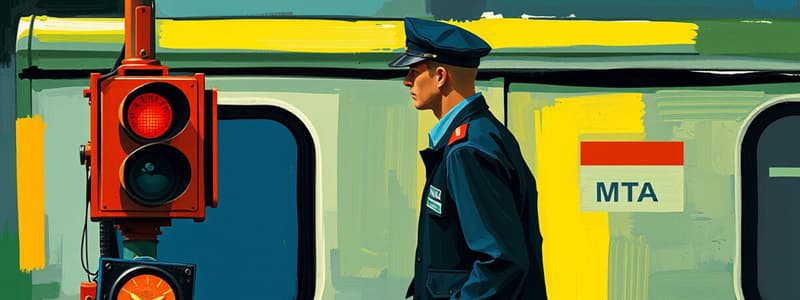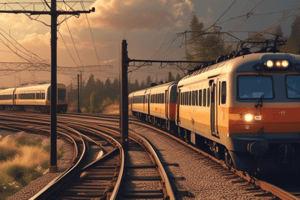Podcast
Questions and Answers
What is an Absolute Block?
What is an Absolute Block?
- A block where no train is permitted to enter while it is occupied (correct)
- A block for maintenance purposes
- A block where trains can enter freely
- A block with uncontrolled signals
What does BLOCK refer to in rail terminology?
What does BLOCK refer to in rail terminology?
A length of track with defined limits, governed by signals.
What is a Controlled Block?
What is a Controlled Block?
The block between successive controlled signals in CTC territory.
Define a Manual Block.
Define a Manual Block.
What is a Deadhead Train?
What is a Deadhead Train?
What does ENGINE refer to?
What does ENGINE refer to?
What is meant by Equipment in rail terminology?
What is meant by Equipment in rail terminology?
What is an Extra Train?
What is an Extra Train?
Define a Freight Train.
Define a Freight Train.
What does Light Engine refer to?
What does Light Engine refer to?
What is M-Series Equipment?
What is M-Series Equipment?
What does Non-Shunting Equipment mean?
What does Non-Shunting Equipment mean?
What is a Track Car?
What is a Track Car?
Define a Train.
Define a Train.
What is a Blocking Device Removed (BDR) Code?
What is a Blocking Device Removed (BDR) Code?
What are Interlocking Signals?
What are Interlocking Signals?
What does Maximum Authorized Speed (MAS) refer to?
What does Maximum Authorized Speed (MAS) refer to?
What is a Passenger Station?
What is a Passenger Station?
What is a Clearance Point?
What is a Clearance Point?
What does a Derail do?
What does a Derail do?
Define a Switch.
Define a Switch.
What is an Automatic Train Control (ATC)?
What is an Automatic Train Control (ATC)?
What does CTC stand for?
What does CTC stand for?
Flashcards are hidden until you start studying
Study Notes
Train Operations Terminology
- Absolute Block: A protected block where no train may enter while occupied.
- Block: Defined track length with limits governed by signals or rules.
- Controlled Block: Blocks between controlled signals in Centralized Traffic Control (CTC) areas.
- Manual Block: Main track section limited by two block limit signals.
Train Types and Operations
- Deadhead Train: Passenger train operating without revenue passengers.
- Engine: Any propulsion unit used in train or yard service, which can include diesel and electric units.
- Equipment: Refers to railroad cars, engines, or track vehicles.
- Extra Train: A train not listed in schedules, designated by direction.
- Freight Train: Any train that carries goods rather than passengers.
- Light Engine: An engine operating without cars; excludes multiple units.
- M-Series Equipment: Refers to specific MU passenger car types (M-3, M-7, M-8).
Track Adjustments and Safety
- Non-Shunting Equipment: Equipment that cannot shunt track circuits, such as single MU cars or track cars.
- Track Car: Specialized vehicles for track maintenance or inspections.
- Train: A coupled unit with engines or cars, also indicating the presence of a marker.
Signal and Control Definitions
- Blocking Device Removed (BDR) Code: Unique code transmitted to workers prior to fouling a track.
- Interlocking: Signals and devices that require correct sequence operations according to interlocking rules.
- Interlocking Signal: Fixed signals that regulate movement at interlocking points.
- Maximum Authorized Speed (MAS): Speed limit established by operating rules.
- Controlled Signal: Fixed signals under the authority of a Rail Traffic Controller (RTC).
- Distant Signal: Indicator used to govern the approach toward interlocking signals.
- Cab Signal: In-cab signal conveying the permissible speed for the train.
Speed Regulations
- Limited Speed: Maximum speed of 45 MPH for passenger trains; 25 MPH for others.
- Medium Speed: Maximum speed of 30 MPH for passenger trains; 15 MPH for others.
- Slow Speed: Maximum speed capped at 15 MPH.
Infrastructure and Control Locations
- Controlled Point (CP): A station where signal control is remote from the Operations Control Center.
- Passenger Station: Designated locations for boarding and disembarking passengers.
- Yard: Area with yard tracks managed by a Yardmaster for various train operations.
- Operations Control Center (OCC): Central location where RTCs manage train movements.
Rules and Notices
- Bulletin Order (BO): A temporary order affecting train movements issued by senior operations authority.
- Daily Train Operations Bulletin Order (DTOBO): Order containing critical operational information issued daily.
- General Notice (GN): Operational instructions not affecting trains' movement.
- General Order (GO): Permanent changes to operational guidelines.
- Employee Special Instructions (SI): Documentation outlining movement-affecting rules.
Specialized Signal Restrictions
- Speed Limit Sign: Indicates maximum speed until the entire train has passed the designated resume sign.
- Working Limits Stop Sign: Designates a stopping point, requiring permission to pass under specified speed limits.
- End of Block Sign: Denotes the conclusion of manual block rules, transitioning to non-controlled track.
This structured summary provides key details on train operation terminology and regulations for effective study and understanding of MTA conductor operations.
Studying That Suits You
Use AI to generate personalized quizzes and flashcards to suit your learning preferences.




